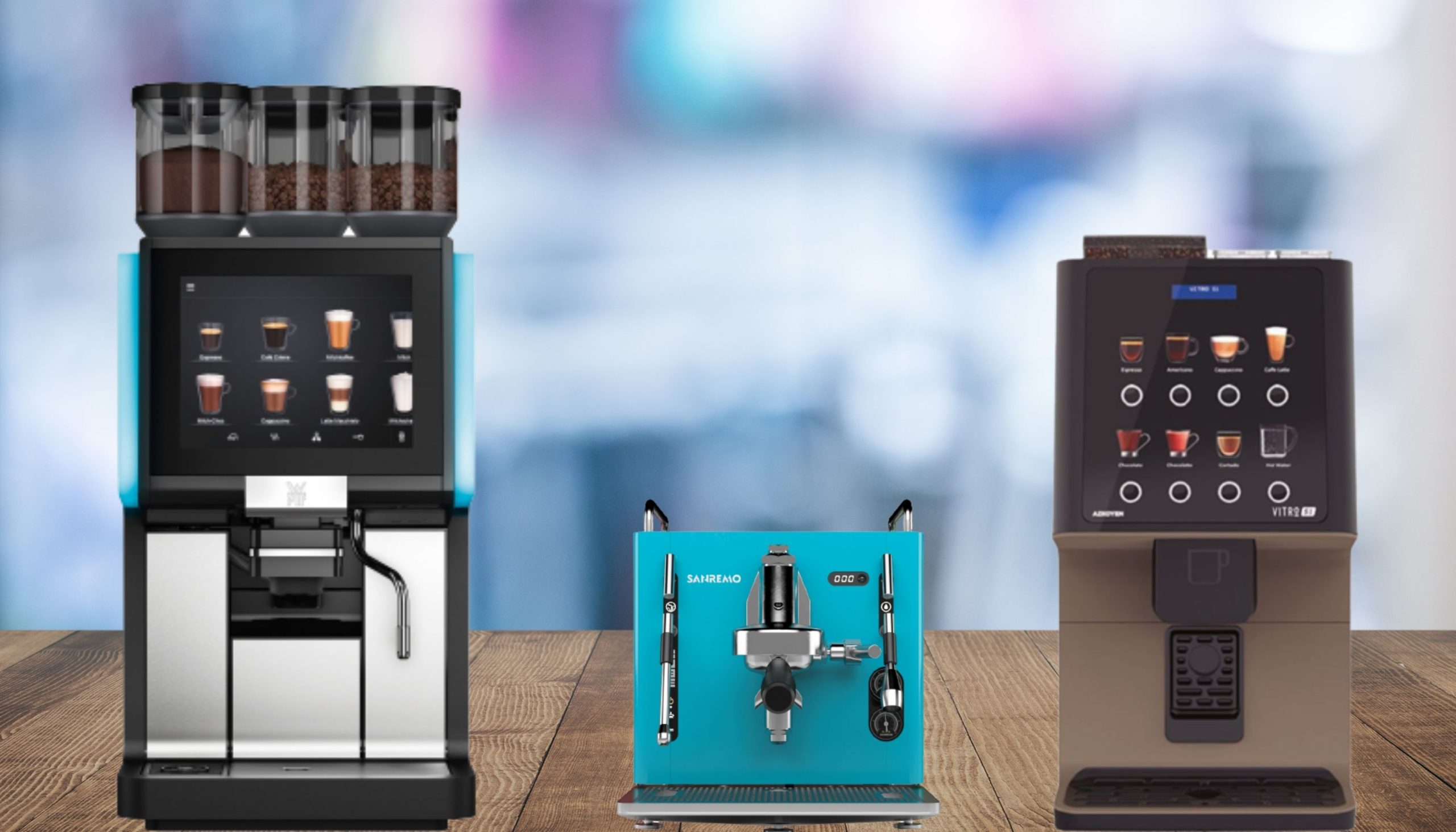Which is the Best Office Coffee Machine? The Ultimate Independent Buyers Guide
Buying, leasing or renting an office coffee machine is a potential minefield, and if you’ve never done it before do yourself a favour and read this first. While most coffee machine suppliers out there are great companies, some are keen to get the sale and run away. Read this and be educated.
[Sassy_Social_Share]What’s covered in this guide:
1: Bean to Cup Automatic Coffee Machines
- Bean to Cup Fresh Milk Machines
- Bean to Cup Powdered Milk Machines
- Instant Coffee Machines
2: Traditional Espresso Machines
- Manual Traditional Espresso Machines
- Semi-Automatic Traditional Espresso Machines
- Pod or Capsule Traditional Machines
3: Filter Coffee Machines
4: Capsule or Pod Machines
- Nespresso-type Capsule Coffee Machines
- Flavia-type Sachet Coffee Machines
5: Number of Cups Per Day
6: Powdered Milk vs Fresh Milk Coffee Machines
7: Touchless Coffee Machines
- App controlled touchless coffee machines
- QR code controlled touchless coffee machines
- Distance selection contactless coffee machines
That’s the intro done, let’s get right into it!
1: Bean to Cup Automatic Office Coffee Machines

Fully automatic office coffee machines are the fastest growing segment of the market, and the reason is that the quality of coffee is getting better than ever, and they’re more robust and feature-packed than ever. Prices vary from £1,000 at the low end, all the way up to £20,000+ for a top-of-the range machine with all the extras.
Automatic office coffee machines will have at least one coffee (instant or beans) and many will have options for a second coffee like decaf, as well as a chocolate option. Some machines will even offer you a choice of powder canisters so you can get white and regular hot chocolate, as well as sugar or other options.
The main types of Fully Automatic Office Coffee Machine are:
- Bean to Cup Fresh Milk Machines
- Bean to Cup Powdered Milk Machines
- Instant Coffee Machines
Bean to Cup Fresh Milk Office Coffee Machines
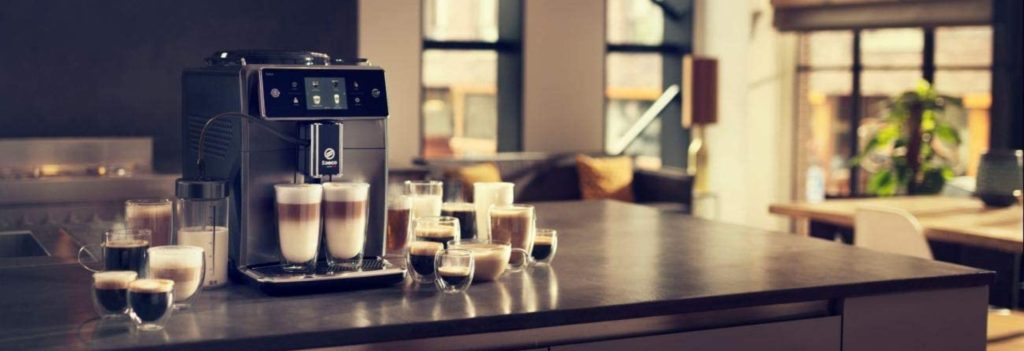
When would you buy a Bean to Cup Fresh Milk Office Coffee Machine?
- Push-button convenience, with the luxury and taste of fresh milk
- For the high-end office, hospitality, restaurants, co-working spaces
- For self-serve or for staff to use when speed is of the essence
A fresh milk office coffee machine is typically supplied with a milk fridge or cooler attached. Be aware that these machines will need dedicated daily cleaning.
Fresh milk machines will range from a small Bravilor Bonamat Sprso machine, for example, all the way to a premium Franke IndividualMilk machine, plus everything inbetween.
An important consideration is the number of cups you will serve/sell/dispense per day. Although most machines will physically be able to make coffee after coffee without pausing, there are a few considerations or limitations:
- Is it a plumbed-in machine or tank-fed?
- How much milk does the cooler hold?
- How many waste grouts will the machine hold before emptying?
- What quantity of beans does the machine hold?
- How much hot chocolate does the machine hold?
- Does it offer more than one coffee type, i.e. decaf?
- Do you need to offer more than one type of milk, e.g. non-dairy alternatives?
Many manufacturers claim that their machine will make two coffees at once, and although it is technically true it’s not normally a benefit. The machine will brew two cups through one dose of coffee, leading to an over-extracted cup. They will also only make two identical cups of coffee, rather than an Americano and a Flat White (for example) simultaneously.
For the best-of-the-best scenarios, machines such as the Schaerer Coffee Soul will have options for Syrup Stations which will add a dose of a flavoured syrup when selected.
If offering more than one milk variety is important, then machines such as the Franke IndividualMilk machine will also have a choice of two different milk types. If your budget doesn’t stretch that far, consider a smaller machine which has a manual milk steaming wand for making coffees using alternative milks.
You can expect a coffee from a Fresh Milk Bean to Cup office coffee machine to take at least 40 seconds per cup. Any less than that and you won’t be getting the full extraction time you need from the coffee.
Bean to Cup Powdered Milk Office Coffee Machines

When would you buy a Bean to Cup Powdered Milk Coffee Machine?
- Push-button convenience when speed and ease of maintenance is at a premium
- Typically used in offices or locations where staff won’t be able to attend to the machine at all times
- When you don’t have time to do a daily clean of a fresh milk machine.
A key benefit of a powdered milk office coffee machine is that the milk is stored inside the machine in a canister, and doesn’t need refrigeration. Many powdered milk machines don’t need a dedicated daily cleaning routine, but rather can be programmed to do a daily rinse. They will still need a full clean once a week.
They will typically make a wide range of drinks, both with and without milk, as well as hot chocolate and hot water for making tea. Some machines like the ZZZ will make freshly brewed tea using real tea leaves, but this is the exception rather than the norm.
Powdered milk machines will range from an entry-level laRhea V machine to the high-volume Vitro X4 Duo machine.
The same considerations apply to powdered milk machines that apply to fresh milk machines. You’ll need to consider the number of cups you will serve/sell/dispense per day. Although most machines will physically be able to make coffee after coffee without pausing, there are a few considerations or limitations:
- Is it a plumbed-in machine or tank-fed?
- How many waste grouts will the machine hold before emptying?
- What quantity of beans does the machine hold?
- How much hot chocolate does the machine hold?
- Does it offer more than one coffee type, i.e. decaf?
Many manufacturers claim that their machine will make two coffees at once, and although it is technically true it’s not normally a benefit. The machine will brew two cups through one dose of coffee, leading to an over-extracted cup. They will also only make two identical cups of coffee, rather than an Americano and a Flat White (for example) simultaneously.
Powdered milk machines don’t tend to have options like syrup stations, but they can have extra powder canisters for things like two varieties of chocolate, or sugar doses.
You can expect a coffee from a Powdered Milk Bean to Cup Coffee machine to take at least 40 seconds per cup. Any less than that and you won’t be getting the full extraction time you need from the coffee.
Instant Office Coffee Machines
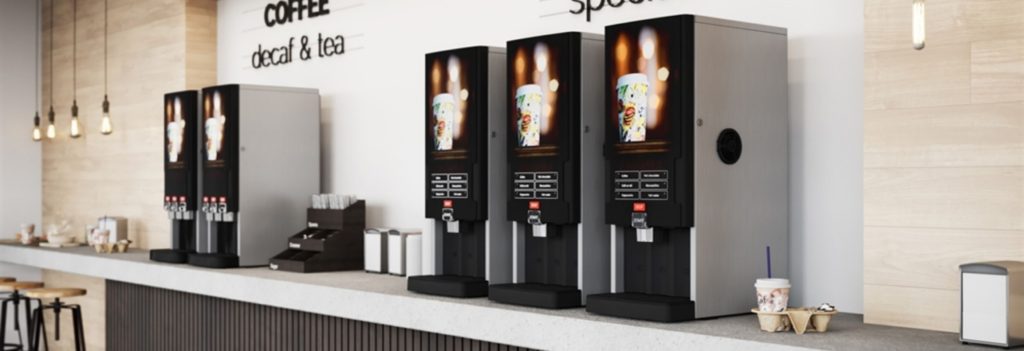
When would you buy an Instant Coffee Machine?
- When speed trumps quality and you need lots of coffee, fast
- Ideal for factories and canteens where many people will need a drink quickly
- For very cheap drink costs
An Instant Office Coffee Machine will normally make a range of coffee drinks, with or without powdered milk, as well as hot chocolate.
Instant office coffee machines range from the very basic Bravilor Bonamat Quinto all the way to a high volume Vitro S4 Instant machine, or even a Back of House Bulk coffee machine such as the Coffetek Excel.
An important consideration is the number of cups you will serve/sell/dispense per day. Although most machines will physically be able to make coffee after coffee without pausing, there are a few considerations or limitations:
- Is it a plumbed-in machine or tank-fed?
- How big are the ingredients canisters?
- Does it offer more than one coffee type, i.e. decaf?
It’s worth checking what size boiler the machine has, as this is going to be one of the biggest limitations in terms of number of drinks a machine will dispense.
An instant coffee machine should make a drink in less than 10 seconds per cup, as a rough guide, depending on the serving size.
2: Traditional Espresso Machines
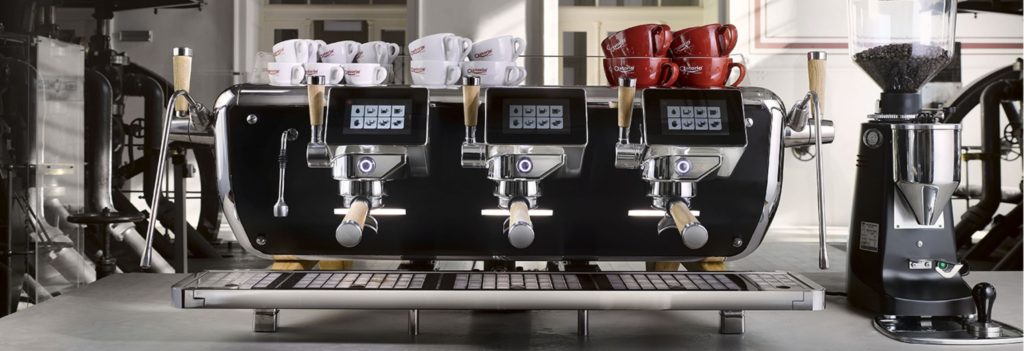
Traditional Espresso Machines are the machines that you’ll see in a typical coffee shop, behind a bar or in a decent restaurant. They’re also often found in high-end offices where staff want the ultimate luxury of making their own coffees – latte art included!
If speed and convenience is what you’re after, you’d be best avoiding a traditional machine and looking at a good quality Bean to Cup machine instead.
A small traditional machine like the Rancilio Silvia Pro is available from as little as £1300, while a top of the range machine like the Sanremo Opera 2.0, for example, can set you back at least £20,000.
The main types of Traditional Espresso Machines are:
- Traditional Espresso Machines
- Semi-Automatic Traditional Espresso Machines
- Pod or Capsule Espresso Machines
Manual Traditional Espresso Machines

When would you buy a Manual Traditional Espresso Machine?
- When nothing but barista-made coffee is good enough
- For the ultimate quality craft coffee when used in the right hands
- To make great quality fresh milk drinks, even on a budget
- When you need to use alternative milks
- If you want to make latte art
A traditional coffee machine will need a separate grinder, unless you get a machine like the Expobar Megacrem which has a grinder built into it to save space. A separate grinder is almost always preferable, as we’re currently not aware of any machines with a built-in grinder that’s an “on demand” grinder which gives the freshest coffee and least wastage.
Price is a big factor, and you’ll really get what you pay for. Smaller machine which are aimed at the domestic market can be very slow and labour under powered. Cheaper machines will suffer from temperature fluctuations which can result in your coffee being over-extracted or under-extracted.
This article is not an exhaustive guide on traditional machines, but this article is very comprehensive and more suited to coffee shops and cafes than an office coffee machine. Check it out.
It’s worth considering whether all your staff will have the ability to make coffee on a traditional machine. If not, it can be a great team-building exercise to get team barista training sessions.
There are a few other important things to consider when looking at a traditional coffee machine:
- Will all your staff be able to make coffees?
- Will the machine need PSSR testing? (this is covered in more depth later on)
- Do you have a sufficient power and water supply?
- Do you have the ability to plumb the machine into drainage?
If this all looks like a bit too much work, it’s worth looking at one of the other options below.
Semi-Automatic Traditional Espresso Machines

So, why would you buy a Semi-Automatic Traditional Espresso Machine?
- If you want “proper” coffee but a fully manual machine is just too fiddly
- Where you need to make coffee with a variety of dairy alternatives
- For when you want to make latte art
A Semi-Automatic Traditional Espresso Machine is essentially a hybrid between a Bean to Cup machine and a Traditional machine, and depending on the model it varies on how much it actually does for you.
Most these machines will grind the coffee and brew the espresso automatically while you steam the milk manually.
These machines aren’t normally cheap, and vary from a machine like the LaCimbali S15 machine and the Gaggia Magenta Plus which is really a home machine, not a commercial machine, and right up to the Eversys Shotmaster at the high end of the spectrum.
As usual, there are a few considerations:
- Is it worth getting a semi-automatic machine when a Bean to Cup machine will do the job?
- Will the machine need PSSR testing?
- Do you have a sufficient power and water supply?
- Do you have the ability to plumb the machine into drainage?
Still not quite what you’re looking for? Let’s introduce you the the Pod or Capsule Espresso Machine.
Pod or Capsule Traditional Machines

These machines are fairly uncommon, so let’s consider why you’d buy one of these:
- Where you want the consistency of capsule or pod coffee, with the craft of a traditional machine
- When you need to make coffee with a variety of dairy alternatives
- When you want to make latte art
- If you want to have a range of different coffees
A Capsule Traditional Espresso Machine is like a Manual Traditional Machine, but instead of grinding fresh coffee you simply use a pre-ground coffee pod instead. This brews the espresso, and you’ll still need to manually steam the milk. Convenient and fresh, but not as cost-effective as using fresh coffee beans in the long run.
These machine are fairly unusual and are not commonly available. A good example is the La Spaziale S15.
Here’s what to think about before you rush out to buy one:
- Have you considered the ongoing cost of coffee capsules?
- Will the machine need PSSR testing? (this is covered in more depth later on)
- Do you have a sufficient power and water supply?
- Do you have the ability to plumb the machine into drainage?
- Have you considered the environmental impact of coffee pods?
3: Filter Coffee Machines for the office
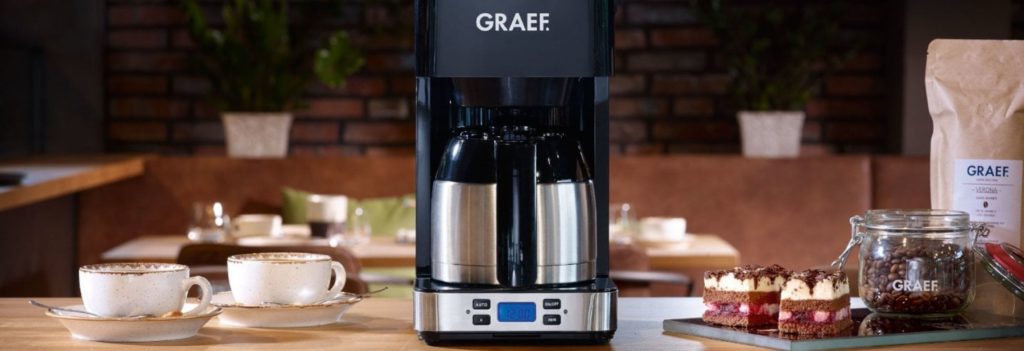
Filter coffee machines exist in an office for two good reasons: Firstly, because they’re incredibly cheap to buy compared with other machines, and secondly because there’s a resident coffee guru who will not drink the coffee out the machine that’s there already.
We’re not going to cover these in much depth from the resident coffee guru point of view, because he or she will already know exactly what they want, and nothing will budge them.
But if you’re considering a filter coffee machine because of budget constraints, here’s a few points to consider:
- Filter coffee machines can be messy and time consuming
- They will only make black filter coffee
- They will only make batches of coffee
- If you want really fresh coffee you’ll need to get a grinder
A couple of good examples are the Moccamaster KBG and the Bravilor Mondo.
4: Capsule or Pod Machines

Capsule, Pod or Sachet type machines are still very common, and the reason behind their popularity is that they’re simple, consistent and very easy to maintain.
Prices vary from the tiny and ghastly Piccolo XS machine at around £35, all the way up to the Franke C250M machine which can cost several thousands.
Capsule or Pod office coffee machines offer you a huge range of different coffee varieties, and many will also offer chocolate or tea drinks as well.
The main types of Pod Machines are:
- Small Nespresso-type capsule machines
- Flavia-type sachet coffee machines
This isn’t an exhaustive list as a new type of machine pops into view every other week, it seems, but this will be a great starting point.
Nespresso-type Capsule Office Coffee Machines

So, when would you buy a Nespresso-style Capsule Coffee Machine?
- Where budget is a massive constraint
- In situations where you only have a handful of people using the office coffee machine
- For boardrooms, receptions or satellite offices
- When you’re catering for a range of different tastes
When we say “Nespresso” type, we’re talking about the machines that you pop a capsule in and in makes a coffee. There are a bunch of different types on the market including the Nespresso, Dolce Gusto or Tassimo.
These are definitely machines that should only be considered when usage will be low or for very small offices. The cost of making a pod-style coffee is a LOT more expensive than using real beans. While a coffee made using real beans can cost between 10 and 15 pence per cup, a pod can cost anywhere between 30 and 80 pence. Here are a few considerations:
- Will a pod machine cope with he volume of drinks being made?
- Have you considered the ongoing cost of pods
- Have you thought about the environmental aspect of using pods?
Capsule or Pod machines are also available in versions that make a coffee using the pod and automatically froth the milk as well. The quality of these drinks are surprisingly good and consistent. The K-Fee Lattensia+ and DeLonghi Lattissima are both great examples.
There are some brilliant environmentally-friendly and compostable pods out there, have a look at Halo Coffee, Waitrose or Roar Gill, as a few examples.
Flavia-type Sachet Coffee Machines
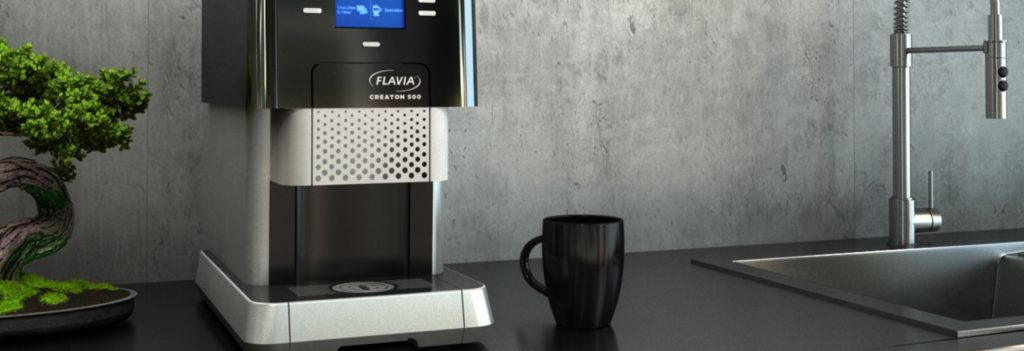
OK, when would you buy a Flavia-style Capsule Coffee Machine?
- Where budget is a massive constraint
- If you only have a handful of people using the machine
- For boardrooms, receptions or satellite offices
- When you’re catering for a range of different tastes
We’re not fans of this type of machine. All the reasons for using them are the same as the other pod-style machines, but we’ve found the quality to be extremely poor. Not a great choice! But there’s good news – if you already have one, you’ll find it very easy to upgrade your coffee next time you’re looking for a machine.
5: Number of Cups Per Day for an office coffee machine

A very important point to consider is how many cups of coffee per day you’ll need a machine to make.
Figures vary on which study you cite, but from our experience and research the average UK worker drinks almost 3 cups of coffee per day. This includes Gerry the IT Manager who falls asleep after 5 minutes if he hasn’t had a coffee, and Susan the HR Manager who worries about insomnia even if she so much as smells a decaf coffee.
A lot of machine manufacturers tend to overstate how many cups per day a machine will make. There are a few things to consider when looking at the machine capacity:
- How much coffee does the coffee hopper hold?
- What size are the powdered ingredient canisters?
- What size is the milk fridge?
- Is the machine plumbed in, or will the tank need regular top-ups?
- How much was coffee with the waste coffee bin hold before needing emptying?
What you’ll hopefully see is that although a machine will make coffee after coffee without stopping in many situations, how often will you need to top up the canisters, empty the bin and top up the fridge and water tank? And if you’re pushing a machine past it’s limits, how long will it last?
Summary:
It’s better to get a machine which has spare capacity rather than a machine that’s always going to be maxed-out.
6: Powdered Milk vs Fresh Milk Office Coffee Machines

This is primarily something to think about when you’re looking at automatic Bean to Cup machines.
Let’s start by looking at the pros and cons of each:
Pros of Powdered Milk Machines
- Powdered milk machines tend to be cheaper
- They are easier to clean
- They don’t need a milk fridge
- The drinks tend to be hotter
- There are less parts to go wrong
Cons of Powdered Milk Machines
- The taste can be poor if used with low quality ingredients
- Cleaning can be neglected because you can “get away with” not cleaning regularly
Pros of Fresh Milk Machines
- The best tasting drink from a bean to cup machine
Cons of Fresh Milk Machines
- They are typically more expensive than a powdered or granulated milk machine
- The need a separate milk fridge
- Daily cleaning needs to be done without fail and is normally more complex
- Drinks tend to be colder than powdered milk drinks
- Repairs and maintenance can be quite pricey
Summary:
It’s all down to convenience vs taste. Granulated or powdered milk is easier to use and maintain, but fresh milk gives the ultimate drink at the expense of extra maintenance and care.
7: Touchless Coffee Machines

Covid-19 has seen a surge of “touchless” or “contactless” coffee machines. What does this mean? It’s a way of using a coffee machine without actually touching any buttons, and by doing so, removing a touch point and potential contamination.
There are currently 3 main ways to operate a Touchless or Contactless Coffee Machine
- App controlled coffee machines
- QR code controlled coffee machines
- Hover touch or air touch coffee machines
App controlled touchless coffee machines

App controlled touchless coffee machines use a downloadable smartphone app as the interface for your coffee machines. Examples include the Newis Touchless App, the TopBrewer Touchless App or the Jura J.O.E. App. They normally “talk” to the coffee machine via Bluetooth or internet connection. They’re great for use in offices where the same people use the machine every day.
Not to be confused with the QR code system below.
Pros of an app controlled touchless coffee machine
- Quick and easy to use
- Drinks can normally be personalised to the user
Cons of an app controlled touchless coffee machine
- You will need to download an app before using it
- Not everyone is comfortable with using an app to make a drink
- Can be expensive to set up
- Not good for locations where visitors are required to use the machine
Summary
Use this system for an office where the same people use it every day, and they’ve comfortable with using an app to make a coffee.
QR code controlled touchless coffee machines

Coffee machines that use a QR code interface to control the machine work something like this: the machine will have a barcode or QR code on the screen, and you scan the code on your smartphone which loads an app-style webpage where you make the drink selection.
Examples include the Schaerer 2nd Screen or the WMF SmartRemote.
Pros of QR code touchless coffee machines
- No app needs to be downloaded
- Quick and easy to use
Cons of QR code touchless coffee machines
- You’ll need to provide instructions on how to use it for visitors
- Not all phones can scan QR codes
- You’ll need a good internet connection
- Watch out for expensive and unnecessary “subscription” fees for this service!
Summary
Somewhat less slick than an app, but better for areas with regular visitors who won’t want to download an app just to make a coffee.
Air Touch or Hover Touch contactless coffee machines

Touchless coffee machines that use the Air Touch or Hover Touch style interface are very simple to use. The interface, which is normally a touch screen, is replaced with a touchless interface instead. To select a drink, you simply point your finger at the button and it senses your selection. Contrary to what many people think, waving your hand in front of it doesn’t make it start dispensing random drinks!
The Coffetek Distance Selection is a good example.
Pros of the Air Touch contactless coffee interface
- No app, smartphone or internet connection needed
- Simple and intuitive
Cons of the Air Touch contactless coffee interface
- Some people just touch the screen anyway
- There have been some reported reliability issues
Summary
If you have no visitors, and you want ultimate customising from your phone, go for the app. And if you want to go low-tech, use the “air touch”. Stuck somewhere in the middle, use the QR code system. But our advice is this: Choose the best coffee machine for your needs, and choose a touchless interface as a secondary consideration. Covid-19 is not going to be here forever!
8: Bringing it all together
Buying a coffee machine for your office is not a 5-minute job. And definitely don’t just go on price. Find a reputable supplier, check out their reviews online and ask for references. Any good supplier won’t struggle to provide you with a few.
Remember that most machines will come with a contract, and it’s important to get it right, else you’ll be stuck with a lemon for a long time!
Happy hunting!

About CoffeeCode
This article was written by Gregg Romano who is the founder of CoffeeCode, the UK’s fastest growing and most exciting coffee blog. CoffeeCode has a focus on great coffee, inspirational design and sustainability.
Credits:
We always do our best to attribute photos, videos and quotes and information to their original sources. Please contact us if an attribution or content is missing or incorrect.


